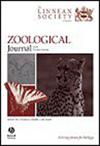比较基因组学揭示了单细胞真核生物Litostomatea类的进化历史及其基于生化代谢能力的适应性进化
IF 3
2区 生物学
Q1 ZOOLOGY
引用次数: 0
摘要
纤毛原生动物是一种单细胞真核生物,其特点是形态多样、分布广泛,并在各种生物学研究中发挥着重要作用。纤毛虫类(Litostomatea)是一个形态多样的纤毛虫类群,由数百种自由生活和内共生物种组成。在这里,我们测序了 14 种捕食性纤毛虫,即 12 种捕食性纤毛虫和 2 种菱形纤毛虫。我们还将这些数据与其他已发表的文昌鱼全息数据进行了比较分析。我们首次对栗口纲进行的系统发生组分析表明,Trichostomatia亚纲和Rhynchostomatia亚纲为单系,Haptoria亚纲为非单系,所有被分析的纲和科均为单系。进化史分析表明,Litostomatea 在新近纪晚期分化,Chaeneidae 科是最早分化的触角目,Rhynchostomatia 可能在古生代早期从 Lacrymariida 目(Haptoria 亚类)中分离出来。对 28 种蝾螈类的终止密码子使用分析表明,它们使用 TAA 作为偏向的终止密码子,并将另外两个终止密码子(TAG 和 TGA)重新分配来编码氨基酸。此外,在 14 个新测序的 litostomateans 中,首选密码子强烈偏向于第三位的 A/U 碱基,这很可能是由于 GC 含量相对较低。编码碳水化合物活性酶(CAZymes)的基因在内共生的三殖吸虫中比在自由生活的捕食性Rhynchostomatia和Haptoria中更加多样化,这表明三殖吸虫具有最强的碳水化合物利用能力。值得注意的是,我们发现三种自由生活的纤毛虫(Didinium sp.1、Myriokaryon sp.和 Apodileptus visscheri)在 CAZymes 的数量上与其他自由生活的纤毛虫有很大的不同。考虑到CAZymes在碳水化合物的降解和生物转化过程中的有效性和多功能性,我们认为这三种纤毛虫多种多样的CAZymes可能是它们获取营养和适应生态位的一种生存策略。最后,对这三种纤毛虫中明显扩大的基因家族进行的功能注释揭示了它们在生化代谢中的强大潜力。这些发现将有助于对纤毛虫进行更广泛的微米尺度系统发育分析,并从进化的角度加深我们对该类群的了解。本文章由计算机程序翻译,如有差异,请以英文原文为准。
Comparative genomics reveals the evolutionary history of the unicellular eukaryote class Litostomatea and its adaptive evolution based on biochemical metabolic capacity
Ciliated protists are unicellular eukaryotic organisms characterized by their morphological diversity, ubiquitous distribution, and the important roles they play in a wide range of biological studies. The class Litostomatea is a morphologically diverse ciliate group that comprises hundreds of free-living and endosymbiotic species. Here, we sequenced 14 predatory litostomateans, i.e. 12 haptorians and two rhynchostomatians. A comparative analysis was performed with other published omics’ data on litostomateans. Our first phylogenomic analysis of litostomateans showed the monophyly of the subclasses Trichostomatia and Rhynchostomatia, the non-monophyly of the subclass Haptoria, and the monophyly of all orders and families that were analysed. Evolutionary history analysis suggested that Litostomatea diverged during the Late Neoproterozoic, the family Chaeneidae was the earliest diverging haptorian lineage, and the Rhynchostomatia probably separated from the order Lacrymariida (subclass Haptoria) during the Early Palaeozoic. Stop codon usage analysis of 28 litostomateans showed that they use TAA as the biased stop codon and reassign the other two stop codons (TAG and TGA) to code for amino acids. In addition, the preferred codons in the 14 newly sequenced litostomateans are strongly biased towards A/U bases in the third position, very probably due to the comparatively low GC content. Genes encoding carbohydrate-active enzymes (CAZymes) are more diversified in the endosymbiotic Trichostomatia than in the free-living predatory Rhynchostomatia and Haptoria, suggesting that trichostomes have the strongest capability of carbohydrate utilization. Notably, we found that three free-living litostomateans (Didinium sp.1, Myriokaryon sp., and Apodileptus visscheri) exhibit substantial differences from other free-living ciliates in terms of their number of CAZymes. Considering the potency and versatility of CAZymes in the degradation and biotransformation of carbohydates, we propose that the multifarious CAZymes in these three ciliates could be a survival strategy for nutrient acquisition and niche adaptation. Finally, the functional annotation of significantly expanded gene families in these three ciliates revealed their vigorous potency in biochemical metabolism. These findings will facilitate wider omic-scale phylogenetic analyses of Litostomatea and deepen our understanding of this group from an evolutionary standpoint.
求助全文
通过发布文献求助,成功后即可免费获取论文全文。
去求助
来源期刊
CiteScore
6.50
自引率
10.70%
发文量
116
审稿时长
6-12 weeks
期刊介绍:
The Zoological Journal of the Linnean Society publishes papers on systematic and evolutionary zoology and comparative, functional and other studies where relevant to these areas. Studies of extinct as well as living animals are included. Reviews are also published; these may be invited by the Editorial Board, but uninvited reviews may also be considered. The Zoological Journal also has a wide circulation amongst zoologists and although narrowly specialized papers are not excluded, potential authors should bear that readership in mind.

 求助内容:
求助内容: 应助结果提醒方式:
应助结果提醒方式:


